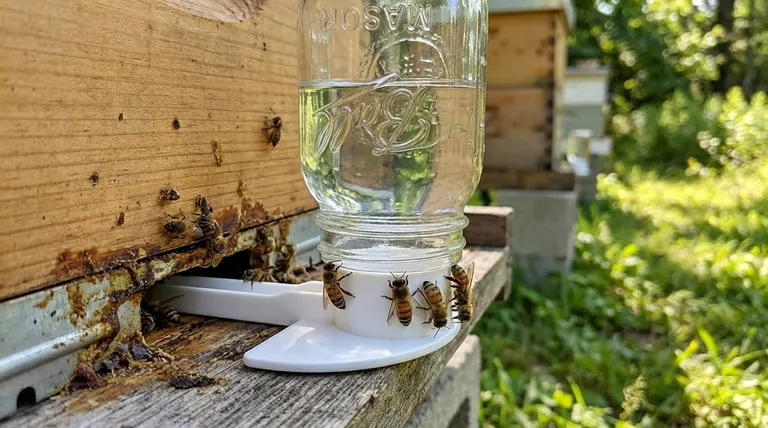The single best alternative use for a front feeder is to provide water. While commonly sold with beginner kits for feeding syrup, using an entrance feeder for sugar water often creates more problems than it solves. Its placement at the hive's entrance is a major liability that can actively harm your colony by encouraging robbing.
The core issue with entrance feeders is their location. Placing syrup at the front door of the hive is an open invitation for robbers, which can decimate a colony. Repurposing these feeders for water transforms them from a high-risk tool into a valuable asset for hive health and safety.

The Fundamental Flaw of Feeding Syrup at the Entrance
Understanding why entrance feeders (also known as Boardman feeders) are poorly suited for syrup is critical. The problem isn't the feeder itself, but where it forces you to place the food.
Inciting a Robbing Frenzy
The smell of sugar syrup placed directly at the hive's entrance acts as a powerful, unmistakable beacon. It attracts robber bees from neighboring hives and other pests like wasps and ants, often triggering a violent robbing event that a weaker colony cannot survive.
Risk of Drowning and Spoilage
Bees can easily find their way into the feeder tray or jar and drown in the syrup. Furthermore, the syrup is exposed to direct sunlight and outdoor temperatures, leading to rapid fermentation and spoilage in warm weather.
Insufficient Capacity
Most entrance feeders use a small quart jar. This volume is entirely insufficient for critical feeding periods, such as preparing a hive for winter or stimulating spring buildup, forcing you to constantly disturb the colony with refills.
The Ideal Role: A Dedicated Water Station
By switching from syrup to water, you eliminate the risks and provide a resource that is just as critical for the colony's survival.
Why Your Bees Need Consistent Water
Water is essential for the colony's daily operations. Bees use it to cool the hive through evaporative cooling on hot days, to dilute thick or crystallized honey, and to create the "bee bread" necessary for feeding larvae.
Reducing Foraging Dangers
Foraging for water can be hazardous. Providing a clean source at the hive entrance prevents bees from drowning in swimming pools, puddles, or birdbaths. It also reduces their exposure to potentially contaminated sources like agricultural runoff or chlorinated water.
Eliminating the Robbing Signal
Unlike scented syrup, plain water does not trigger an intense foraging response from robbers. It provides a necessary resource for your bees without advertising the hive's location and stores to outsiders.
Understanding the Trade-offs and Alternatives
Repurposing your feeder is a strategic decision. While excellent for water, it's important to recognize its limitations and know the superior options for feeding.
When a Water Feeder is Most Critical
An entrance waterer is most beneficial during hot, dry summer months, during a nectar dearth when natural sources dry up, or in urban and suburban areas where clean water is scarce.
Superior Alternatives for Feeding Syrup
For feeding syrup, internal feeders are a far safer and more effective choice. Top feeders and in-hive frame feeders hold larger volumes (one to three gallons) and keep the syrup securely inside the hive, drastically reducing the risk of robbing.
The Remaining Limitation
Even when used for water, the small capacity of an entrance feeder remains its primary drawback. On extremely hot days, a strong colony can easily empty a quart jar, so you must still monitor it.
Making the Right Choice for Your Goal
Use your equipment to solve the right problem. Your entrance feeder has a valuable, but specific, role to play in your apiary.
- If your primary focus is feeding syrup for winter stores or colony buildup: Use a high-capacity internal feeder, such as a top feeder or frame feeder, to prevent robbing and feed efficiently.
- If your primary focus is supporting colony health and reducing foraging stress: Use your entrance feeder exclusively for providing a clean, reliable source of water, especially during hot and dry periods.
Using the right tool for the right job is the hallmark of a strategic beekeeper.
Summary Table:
| Use Case | Benefits | Key Considerations |
|---|---|---|
| Feeding Water | Prevents robbing, provides essential hydration, reduces foraging risks. | Small capacity requires monitoring; ideal for hot/dry periods. |
| Feeding Syrup | Direct access for bees. | High risk of robbing, spoilage, and drowning; insufficient capacity. |
Upgrade Your Apiary's Efficiency and Safety with HONESTBEE
As a commercial apiary or beekeeping equipment distributor, ensuring your colonies are healthy and productive is paramount. The right equipment makes all the difference. While an entrance feeder has its place as a water source, reliable, high-capacity internal feeders are essential for safe and effective syrup feeding.
HONESTBEE supplies the durable, wholesale-focused beekeeping supplies and equipment you need to manage your operations successfully. From top feeders that prevent robbing to other essential tools, we help you protect your investment and maximize hive health.
Let's discuss your specific needs. Contact our team today to explore our product range and wholesale solutions.
Visual Guide

Related Products
- HONESTBEE Entrance Bee Feeder Efficient Hive Front Liquid Feeding Solution for Beekeeping
- Classic Boardman Entrance Bee Feeder Hive Front Feeding Solution
- In-Hive Dual Compartment Frame Bee Feeder for Targeted Colony Nutrition
- HONESTBEE Entrance Bee Feeder Professional Hive Nutrition Solution for Beekeeping
- Boardman Entrance Bee Feeder Durable Galvanized Steel and Wood Construction for Beekeeping
People Also Ask
- Are entrance feeders good for bees? Prioritize Hive Health Over Convenience
- What strategy was used to eliminate summer migration in the Sierra foothills? Proactive Feeding Based on Brood Signals
- How does a bee entrance feeder work? A Simple Guide to Convenient Hive Feeding
- How to make an entrance feeder for bees? A DIY Guide for Safe & Effective Feeding
- How do you make an entrance feeder for bees? A Guide to Safe & Effective Hive Feeding



















